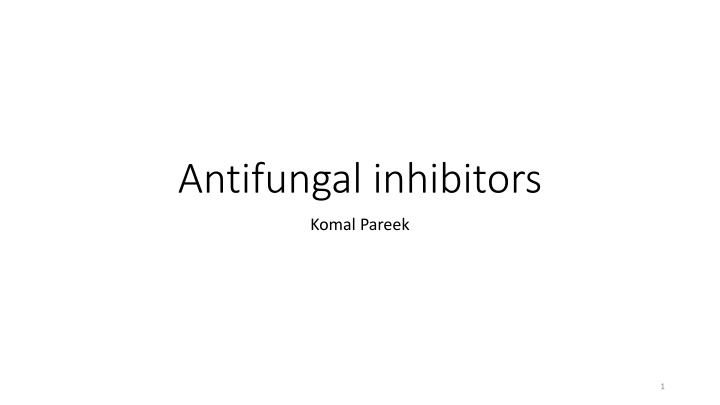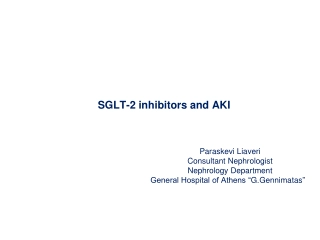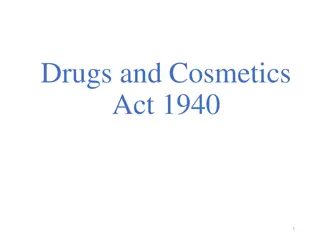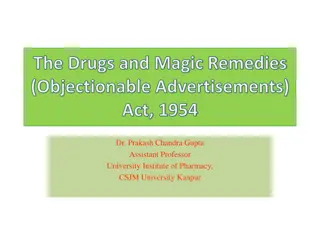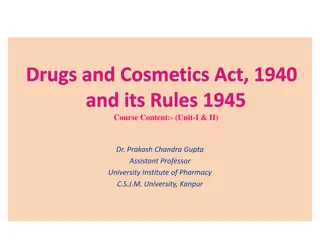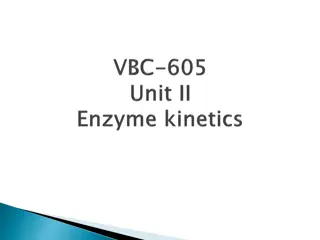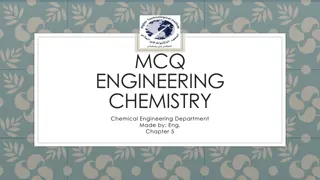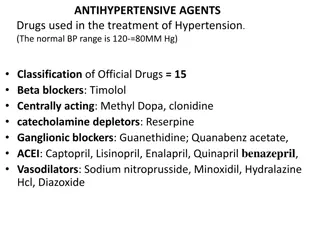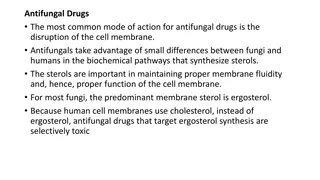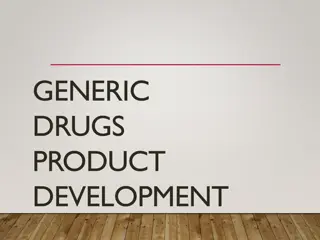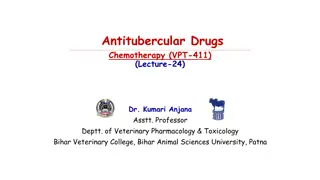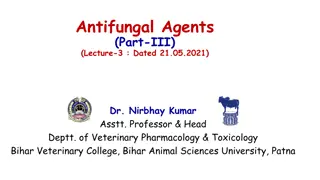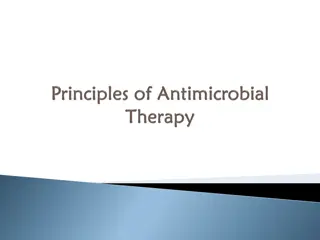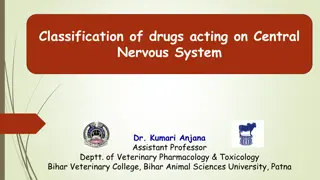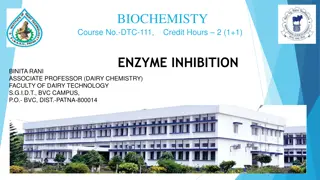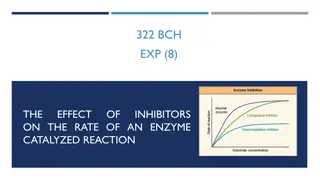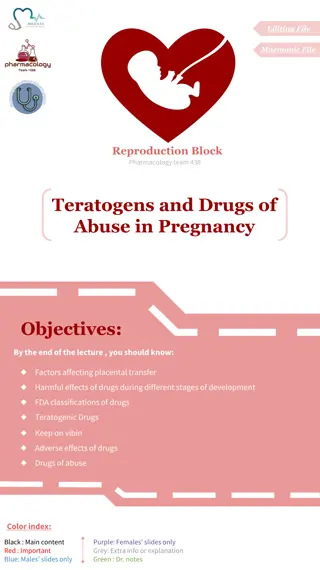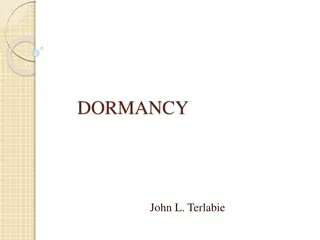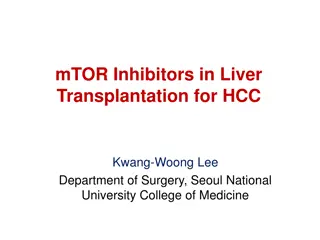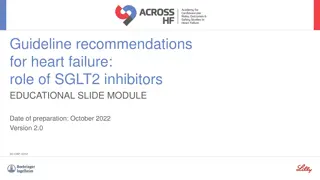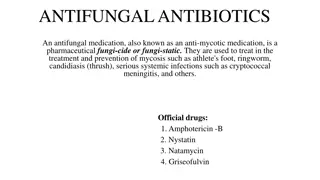Antifungal Inhibitors and Drugs
In this detailed overview, we explore antifungal inhibitors and drugs, including their mechanisms of action, impact on eukaryotes and prokaryotes, common agents affecting fungal sterols and cell walls, as well as synthetic antifungals. From polyenes like nystatin to azoles such as voriconazole, this compilation provides valuable insights into the treatment of fungal infections. Additionally, antimycotic antibiotics and systemic antifungals like amphotericin B are discussed, shedding light on their uses and potential toxicities.
Download Presentation

Please find below an Image/Link to download the presentation.
The content on the website is provided AS IS for your information and personal use only. It may not be sold, licensed, or shared on other websites without obtaining consent from the author.If you encounter any issues during the download, it is possible that the publisher has removed the file from their server.
You are allowed to download the files provided on this website for personal or commercial use, subject to the condition that they are used lawfully. All files are the property of their respective owners.
The content on the website is provided AS IS for your information and personal use only. It may not be sold, licensed, or shared on other websites without obtaining consent from the author.
E N D
Presentation Transcript
Antifungal inhibitors Komal Pareek 1
Challenge Eukaryotes Difficult to find selective toxicity in eukaryotes than prokaryotes Fungal infections r more frequent as opportunistic infections in immunocompromised Cell membrane essential component- sterol Fungi-Ergosterol Higher animals- cholesterol 2
Antifungal inhibitors Agents affecting Fungal Sterols Azoles- Voriconazole Polyenes-Amphotericin B, Nystatin Agents affecting Fungal cell walls Echinocandins Agents inhibiting Nucleic acid-flucytocine Other Antifungal drugs-Griseofulvin 3
Antifungal Drugs Antifungal Drugs Polyenes, such as nystatin and amphotericin B, for systemic fungal infections. Inhibition of ergosterol synthesis fungicidal. Nephrotoxic Griseofulvin from Penicillium. Systemic/oral. Binds to tubulin For Tineae 4
Antimycotic Antibiotics Polyenes Broad spectrum. Some effect on certain protozoa. Isolated, Streptomyces sp. Binds to sterols in fungal cell membrane; cell leaks K+, PH drops , small org. molecules Macrolaktone [26 eor 38-ring, Larger than macrolides ( erytromycin etc)] Polyene (Macrolides not polyenes) Several OH-groups amino sugar, Bad water solibility. 5
OH OH O OH HO O HO OH HO HO O CO2H Amfotericin B Systemic infect (infusion) Somewhat less toxic. O O Amfotericin B OH NH2 OH Clinical treatment for systematic fungal diseases-histoplasmosis, coccidiomycosis and blastomycosis Toxicity-to kidney- strong limiting factor in use Administering the drug encapsulated in lipids(liposomes)appears to minimize toxicity 6
OH OH O OH HO O HO HO HO HO O Nystatin A Toxic, Topical(Local) treatment, CO2H O O NH2 OH Nystatin A OH Nystatin (originally named Fungicidin) is a polyene antifungal medication that is derived from a bacterium, Streptomyces noursei. Many mold and yeast infections are sensitive to nystatin, most notably Candida. It is used primarily for infections involving the skin, mouth, oesophagus, and vagina 7
Synthetic Antifungals Azoles N N N NN N H N H N H H Azol / Pyrrol 1,2-Diazol 1,2,4-Triazol 1,3-Diazol / Imidazol Inhibit the synthesis of sterol components of fungal membrane Removes methyl group from lanosterol Azoles reduces ergosterol level .leads to loss of cytoplasmic constituents Side effects- reduces cholesterol synthesis 8
Ketokonazol: Orally-used for systematic fungal infections Less toxic than Amphotercic B Occasional liver damage Topical ointment to treat dermatomycocses Cl Cl O O O N N N O N Voriconazole Replaced Amphotericin B for systematic fungal infection Treatment of Aspergillosis of the CNS .is able to penetrate the blood brain barrier "cis", [ ] 2 or 3 other aromatic rings 9
Griseofulvin Produced by Penicillium griseofulvin Active against superficical dermatophytic fungal infection of the hair(tinea capitis or ringworm) and nails even though it s route of administration is oral. It specifically binds to the keratin found in skin, hair follicles and nails It s mode of infection to block microtubules assembly which interfere with mitosis and thereby inhibits fungal reproduction 10
Anidulafungin Anidulafungin It is a member of the class of antifungal drugs known as the echinocandins; Its mechanism of action is by inhibition of (1 3)- -D-glucan synthase, an enzyme important to the synthesis of the fungal cell wall. Glucan synthase is not present in mammalian cells, so it is an attractive target for antifungal activity. 11
Anidulafungin is manufactured via semisynthesis. The starting material is echinocandin B (a lipopeptide) fermentation product of Aspergillus nidulans Anidulafungin has proven efficacy against esophageal candidiasis, but its main use will probably be in invasive Candida infection; it may also have application in treating invasive Aspergillus infection. 12
